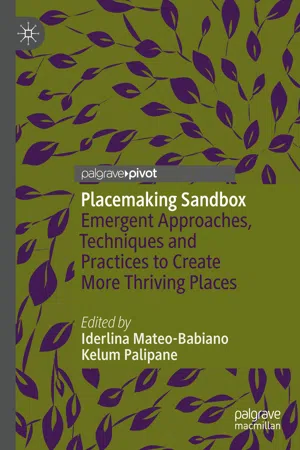Introduction
Place is defined as a ‘constellation of meanings and appropriate behaviours that define an experience in a social setting’.1 Therefore, placemaking is the process of giving meaning to a space and developing positive emotional connections between a person, the community, and the area where they live. It is also a transformative process that encourages citizens to take action in an area to strengthen their sense of place by responding to their local needs and preferences.2,3 In other words, it aims to foster place attachment4,5 and generates a lasting impact on urban development.6
The benefits of high-quality places are well documented and include improved physical and psychological health,7,8,9,10,11 economic benefits such as increased property value and reduced public expenses,12,13 reduced crime and increased perceptions of safety,14,15,16 and active citizenship.17 However, the extent of a project’s ability to generate a lasting impact varies widely from project to project.
Research indicates that there are three key elements in successful placemaking projects: (1) a process that applies deep community engagement; (2) the use of small, often quick, affordable projects that trigger change within an area; and (3) an overarching goal to improve the quality of life of its citizens.18
Placemaking is said to be a purpose-driven process that applies multiple tactics and should be analysed based on five key elements: people, process, product, programme, and place evaluation or the
5P framework (Table
1).
19 Each level of the
5P framework has multiple characteristics that are important for the success and impact level of a project.
Table 1The 5P framework for placemaking
| | Characteristics include |
|---|
People | Including leadership (allowing the people to become active agents of place), deep engagement (who is engaged), and their needs (an exercise to understand the different ways in which people relate to the place by understanding their needs, aspirations, experiences, culture, and relationships). |
Process | A ‘design-with’ exercise where the key role of the placemaker is to create a good environment for communication and empowerment. The process should give agency to the community, use local knowledge, respond to local perspectives, and have a clear purpose driving the project. |
Product | The tangible outcomes of the project including temporary or permanent changes in the urban fabric (i.e., art exhibition and redesign of the main street respectively) or meaningful soft products (i.e., walking tours). |
Program | Place-keeping mechanism used as ‘glue’ for the ongoing emotional connection to place. It includes maintenance, management, and place activation initiatives. Activities should be meaningful based on local needs and interests to enhance the experience of place. |
Place evaluation | Process to monitor and evaluate the intervention and understand the outcomes and legacy of a project. It should incorporate relationship building outcomes and document social, ecological, and economic benefits. |
British architect Matthew Carmona systematically reviewed a number of urban studies that explore the link between place quality and health, well-being, economic success, and environmental sustainability. He explored 271 published papers and has determined that high-quality places require ‘greenness, mix of uses, low levels of traffic, walkability, bikeability, compact and coherent pattern of development, [and] public transport connectivity’.
20 However, even when
placemakers know exactly what attributes are needed to apply in order to ensure high-quality spaces, the sought-after emotional
connection between the community and space and the associated long-term benefits cannot be fully developed (Fincher, 2016; Shaw, 2009).
21,22 The recent research on tertiary education practices for built-environment courses has shown that part of the problem relates to the inability of graduates and built-environment professionals to integrate the necessary processes and relationships into their practice.
23 Thus, as educators, we ask:
How can we support built-environment students to take on the roles of creator and facilitator of a placemaking process?
How do we teach project delivery that can adapt to the iterative nature of placemaking?
Do students have the skills to engage with the community, resolve conflict, and encourage people to become active citizens?
Placemaking flips the power balance and thus enables the community to become the key driver of design while the designer often takes on a role of facilitating the process and providing support.24 As such, any educational programme aiming to educate students in placemaking should support facilitation capacity. This requires holistic learning approaches that give students not only the cognitive theories and concepts of high-quality design, but also the soft-skills required to work with the community, build on trust, and develop meaningful relationships.25
The Head, Heart, and Hand Model: A Pedagogy for Holistic Learning
To work in placemaking, students need to come out of their educational experience, be able to adapt their skills and knowledge to the context of their work,26 and to continually improve them through reflection.27 Thus, it is critical for them to learn the cognitive skills relevant to the understanding of place and placemaking, the affective skills needed for placemaking process, and the practical skills for the implementation of place-based practice.28,29 As mentioned, recent research has shown that the current approaches to teaching are heavily biased towards cognitive development through coursework (lectures) an...
